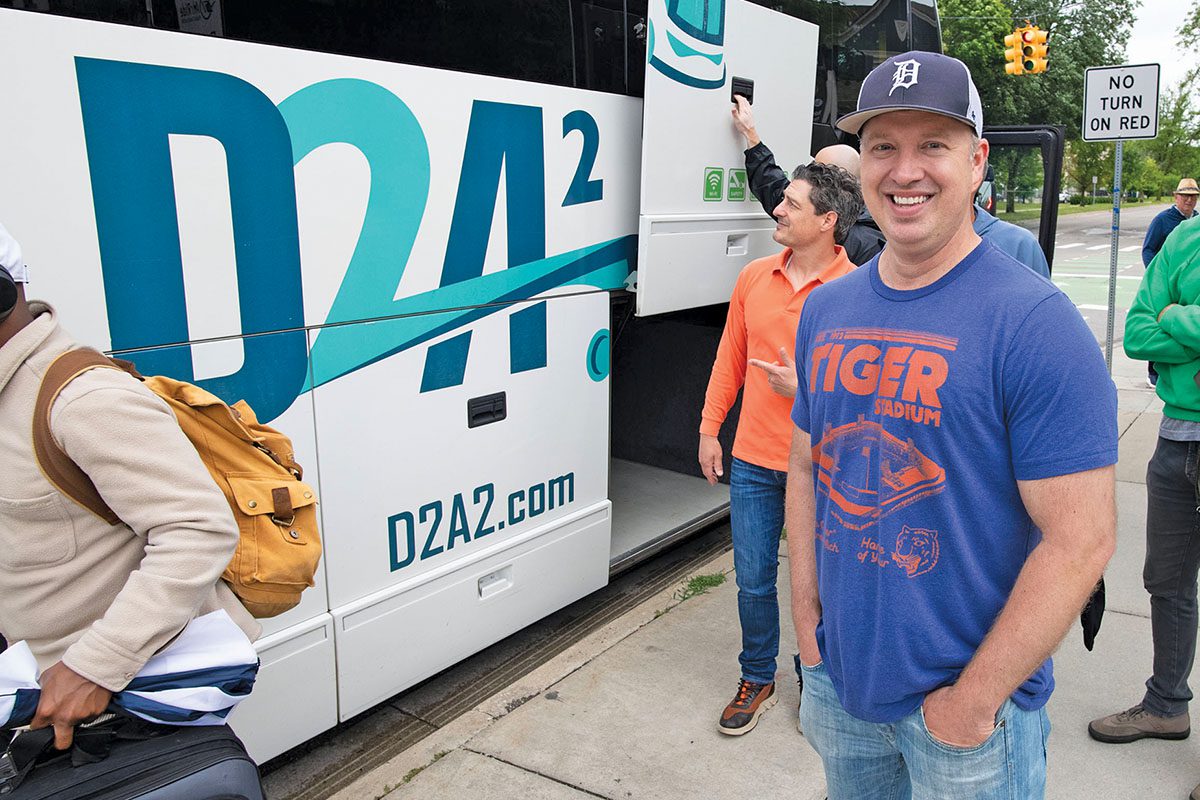
“I don’t know if I’m the #1 D2A2 fan in Ann Arbor, but I at least have to be close,” Mike Daniel emails. He was taking the bus so often that he sprang for a frequent-rider deal: he paid $100 for fifty rides, and used them all in about nine months. | Photo by Mark Bialek
The bus departs from Fifth Ave. opposite the downtown library sixteen times daily during the workweek. About fifty minutes later, it arrives at Detroit’s Grand Circus Park. Serving a mix of day trippers and commuters, “D2A2 ridership is currently 60% higher this year as it was at this point last year,” emails a staffer at the Regional Transit Authority of Southeast Michigan.
When Detroit hosted the NFL Draft in April, they brought on extra buses and provided a record 8,500 rides in three days.
RTA funds the pilot service; the Ann Arbor Area Transportation Authority operates it through a contract with private bus line Indian Trails. From Grand Circus Park, Ann Arbor passengers can catch the Q-line streetcar, the People Mover monorail, and Detroit Department of Transportation and regional SMART buses, which connect as far north as Pontiac.
Tom Jensen has taken the bus to see the Tigers, Pistons, and Lions play, as well as concerts at the Detroit Symphony and shows at the Fisher Theatre. Jensen lives out-of-state but returns frequently to visit his family in Ann Arbor. “I generally don’t have a car” when he visits, he emails, “so I wouldn’t have access to all of that without the D2A2.”
U-M administrator Mike Daniel got hooked three years ago, when he and a friend attended a Red Wings game, departing in late morning and returning at 11 p.m. Both buses, he emails, arrived on time, had friendly drivers, and offered amenities like phone chargers and restrooms. “The kicker is just how AFFORDABLE it is,” he writes. Fares are $6 each way when purchased at d2a2.com, or $8 on the bus. And Daniel “was taking it enough that I sprung for the 50 rides for $100 option and used all 50 rides in about 9 months,” he writes. “I don’t know if I’m the #1 D2A2 fan in Ann Arbor, but I at least have to be close.”
Matt Bredeweg takes the bus daily to his law-firm job in Detroit, sometimes riding the last half-mile to his office on an electric skateboard. “I love not having to drive,” Bredeweg says. “I don’t need the aggravation. I love the ecological factor.”
Vanesa Jackson commutes in the opposite direction.”I got priced out of Ann Arbor,” says Jackson as she waits for a bus at the Blake Transit Center. “My rent went up 20 percent last year.” Moving to downtown Detroit saved her $500 a month. Unlike her Ann Arbor apartment, her new place is air-conditioned—and the bus made it easy to keep her job at U-M.
AAATA CEO Matt Carpenter says the service grew out of discussions with then-RTA chief operating officer Matt Webb in 2018. Voters had recently turned down a four-county millage that would have greatly expanded regional transit, but it had passed in Washtenaw. “I pitched to him an idea to connect the Ann Arbor and Detroit areas, specifically the downtowns, with a high-speed commuter bus,” Carpenter recalls.
The U-M was running a shuttle into the city for students and staff, but was willing to shut it down if there was a better alternative, Carpenter says. Its passengers could provide “a reliable base core of ridership.”
After months of discussion, RTA agreed to fund the service as a pilot, drawing from a state grant. Since the organization didn’t have the staff to run it, TheRide handled that. “RTA cuts us a check, and we pay the contractor,” Carpenter explains.
The service had “the worst timing of a product launch, maybe, in the history of the world,” Carpenter says: the first buses had been rolling just three weeks when the first pandemic shutdown hit in March 2020. It didn’t restart until the following year.
Related: Transit in Transition
Hydrogen Buses?
Though D2A2 is building a fan base, its future is uncertain. “My understanding is that the last of the original funding may run out at the end of the year,” Carpenter says, “but that RTA may have access to ARPA [pandemic relief] funding that they’re able to use to keep the service running a little longer.”
The RTA staffer confirms that the regional authority “is exploring funding options for how we can extend this service thanks to the tremendous demand.”